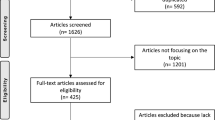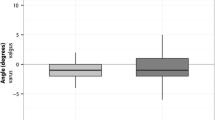Abstract
Purpose
The minimally invasive surgical (MIS) approach has been popularised as an alternative to the standard medial parapatellar approach (MPP) in total knee arthroplasty (TKA). Advocates of this technique suggest earlier functional recovery due to less injury to the surrounding tissues. Potential disadvantages however may include reduced overall exposure, component malalignment and damage to neurovascular structures.
Methods
A systematic review and meta-analysis of randomised and quasi-randomised trials were conducted to compare the MIS and MPP approaches in primary TKA. Methodological features were rated independently by two reviewers.
Results
Seventeen studies were included involving 733 patients with mean age of 69 (SD ± 2.8) in the MIS group and 692 patients with mean age of 68.6 (SD ± 3.1) in the MPP group. Using a MIS approach led to significant increase in flexion within the first week after a TKA (mean difference (MD) of 9.9° (95% confidence interval (CI) 8.2–11.6, P < 0.01)). However, this effect was not sustainable at further follow-ups of ≥3 months. MIS showed a significantly increased risk of developing intraoperative complications with a risk ratio (RR) of 7.6 (95% CI 3.5–16.3, P < 0.01).
Conclusion
MIS results in superior function in the immediate postoperative period after a primary TKA but is also associated with increased rates of intraoperative complications, and therefore, a standard approach that allows adequate exposure and avoids tension to the wound edges would be more appropriate to prevent such complications.
Level of evidence
Therapeutic study, Level I.




Similar content being viewed by others
References
Aglietti P, Baldini A, Sensi L (2006) Quadriceps-sparing versus mini-subvastus approach in total knee arthroplasty. Clin Orthop Relat Res 452:106–111
Bathis H, Perlick L, Blum C, Luring C, Perlick C, Grifka J (2005) Midvastus approach in total knee arthroplasty: a randomized, double-blinded study on early rehabilitation. Knee Surg Sports Traumatol Arthrosc 13 (7):545–550
Boerger TO, Aglietti P, Mondanelli N, Sensi L (2005) Mini-subvastus versus medial parapatellar approach in total knee arthroplasty. Clin Orthop Relat Res 440:82–87
Bonutti PM, Mont MA, McMahon M, Ragland PS, Kester M (2004) Minimally invasive total knee arthroplasty. J Bone Jt Surg Am 86-A (Suppl 2):26–32
Cheng T, Liu T, Zhang G, Peng X, Zhang X (2010) Does minimally invasive surgery improve short-term recovery in total knee arthroplasty? Clin Orthop Relat Res 468:1635–1648
Chin PL, Foo LS, Yang KY, Yeo SJ, Lo NN (2007) Randomized controlled trial comparing the radiologic outcomes of conventional and minimally invasive techniques for total knee arthroplasty. J Arthroplasty 22 (6):800–806
Chotanaphuti T, Ongnamthip P, Karnchanalerk K, Udombuathong P (2008) Comparative study between 2 cm limited quadriceps exposure minimal invasive surgery and conventional total knee arthroplasty in quadriceps function: prospective randomized controlled trial. J Med Assoc Thai 91 (2):203–207
Engh GA, Holt BT, Parks NL (1997) A midvastus muscle-splitting approach for total knee arthroplasty. J Arthroplasty 12 (3):322–331
Gandhi R, Smith H, Lefaivre KA, Davey JR, Mahomed NN (2009) Complications after minimally invasive total knee arthroplasty as compared with traditional incision techniques: a meta-analysis. J Arthroplasty 26 (1):29–35
Haas SB, Cook S, Beksac B (2004) Minimally invasive total knee replacement through a mini midvastus approach: a comparative study. Clin Orthop Relat Res 428:68–73
Han I, Seong SC, Lee S, Yoo JH, Lee MC (2008) Simultaneous bilateral MIS-TKA results in faster functional recovery. Clin Orthop Relat Res 466:1449–1453
Handoll H, Elstub L, Elliot J (2008) Cochrane bone, joint and muscle trauma group. About the Cochrane collaboration (Cochrane Review Groups (CRGS)) Issue 4 Art. No: MUSKINJ
Hernandez-Vaquero D, Noriega-Fernandez A, Suarez-Vazquez A (2010) Total knee arthroplasties performed with a mini-incision or a standard incision. Similar results at six months follow-up. BMC Musculoskelet Disord 11:27
Higgins JPT, Green S (eds) (2011) Cochrane Handbook for Systematic Reviews of Interventions Version 5.1.0. In: The cochrane collaboration. Available via HYPERLINK. http://www.cochrane-handbook.org
Hozo SP, Djulbegovic B, Hozo I (2005) Estimating the mean and variance from the median, range, and the size of a sample. BMC Med Res Methodol 5 (1):13
Juosponis R, Tarasevicius S, Smailys A, Kalesinskas RJ (2009) Functional and radiological outcome after total knee replacement performed with mini-midvastus or conventional arthrotomy: controlled randomised trial. Int Orthop 33 (5):1233–1237
Karachalios T, Giotikas D, Roidis N, Poultsides L, Bargiotas K, Malizos KN (2008) Total knee replacement performed with either a mini-midvastus or a standard approach: a prospective randomised clinical and radiological trial. J Bone Jt Surg Br 90 (5):584–591
Karpman RR, Smith HL (2009) Comparison of the early results of minimally invasive vs standard approaches to total knee arthroplasty: a prospective, randomized study. J Arthroplasty 24 (5):681–688
Kashyap SN, van Ommeren JW (2008) Clinical experience with less invasive surgery techniques in total knee arthroplasty: a comparative study. Knee Surg Sports Traumatol Arthrosc 16 (6):544–548
Khanna A, Gougoulias N, Longo UG, Maffulli N (2009) Minimally invasive total knee arthroplasty: a systematic review. Orthop Clin N Am 40 (4):479–489
Kim YH, Kim JS, Kim DY (2007) Clinical outcome and rate of complications after primary total knee replacement performed with quadriceps-sparing or standard arthrotomy. J Bone Jt Surg Br 89 (4):467–470
Kolisek FR, Bonutti PM, Hozack WJ, Purtill J, Sharkey PF, Zelicof SB, Ragland PS, Kester M, Mont MA, Rothman RH (2007) Clinical experience using a minimally invasive surgical approach for total knee arthroplasty: early results of a prospective randomized study compared to a standard approach. J Arthroplasty 22 (1):8–13
Laskin RS (2004) Minimally invasive total knee replacement using a mini-mid vastus incision technique and results. Surg Technol Int 13:231–238
Laskin RS, Beksac B, Phongjunakorn A, Pittors K, Davis J, Shim JC, Pavlov H, Petersen M (2004) Minimally invasive total knee replacement through a mini-midvastus incision: an outcome study. Clin Orthop Relat Res 428:74–81
Luring C, Beckmann J, Haibock P, Perlick L, Grifka J, Tingart M (2008) Minimal invasive and computer assisted total knee replacement compared with the conventional technique: a prospective, randomised trial. Knee Surg Sports Traumatol Arthrosc 16 (10):928–934
McAllister CM, Stepanian JD (2008) The impact of minimally invasive surgical techniques on early range of motion after primary total knee arthroplasty. J Arthroplasty 23 (1):10–18
Nestor BJ, Toulson CE, Backus SI, Lyman SL, Foote KL, Windsor RE (2010) Mini-midvastus versus standard medial parapatellar approach: a prospective, randomized, double-blinded study in patients undergoing bilateral total knee arthroplasty. J Arthroplasty 25 (Suppl 6):5–11
Pan WM, Li XG, Tang TS, Qian ZL, Zhang Q, Zhang CM (2010) Mini-subvastus versus a standard approach in total knee arthroplasty: a prospective, randomized, controlled study. J Int Med Res 38 (3):890–900
Parentis MA, Rumi MN, Deol GS, Kothari M, Parrish WM, Pellegrini VD (1999) A comparison of the vastus splitting and median parapatellar approaches in total knee arthroplasty. Clin Orthop Relat Res 367:107–116
Pei-liang F, Xiao-hua L, Yu-li W (2008) Comparison of midvastus and standard medial parapatellar approaches in total knee arthroplasty. Zhongguo Zuzhi Gongcheng Yanjiu Yu Linchuang Kangfu 12 (9):1793–1796
Scuderi GR, Tenholder M, Capeci C (2004) Surgical approaches in mini-incision total knee arthroplasty. Clin Orthop Relat Res 428:61–67
Smith TO, King JJ, Hing CB (2012) A meta-analysis of randomised controlled trials comparing the clinical and radiological outcomes following minimally invasive to conventional exposure for total knee arthroplasty. Knee 19 (1):1–7
Tria AJ (2003) Advancements in minimally invasive total knee arthroplasty. Orthopedics 26 (Suppl 8):859–863
Tria AJ, Coon TM (2003) Minimal incision total knee arthroplasty: early experience. Clin Orthop Relat Res 416:185–190
Varela-Egocheaga JR, Suarez–Suarez MA, Fernandez-Villan M, Gonzalez-Sastre V, Varela-Gomez JR, Rodriguez-Merchan C (2010) Minimally invasive subvastus approach: improving the results of total knee arthroplasty: a prospective, randomized trial. Clin Orthop Relat Res 468 (5):1200–1208
Von Langenbeck B (1879) Zur resection des kniegellenks. Verh d Deutchen Gesellsch F Chir 7:23
Wulker N, Lambermont JP, Sacchetti L, Lazaro JG, Nardi J A (2010) prospective randomized study of minimally invasive total knee arthroplasty compared with conventional surgery. J Bone Jt Surg Am 92 (7):1584–1590
Conflict of interest
We have received no external funding or any writing assistance for the preparation of this paper. None of the authors have any conflicting interest related to the outcomes of this study.
Author information
Authors and Affiliations
Corresponding author
Rights and permissions
About this article
Cite this article
Alcelik, I., Sukeik, M., Pollock, R. et al. Comparison of the minimally invasive and standard medial parapatellar approaches for primary total knee arthroplasty. Knee Surg Sports Traumatol Arthrosc 20, 2502–2512 (2012). https://doi.org/10.1007/s00167-012-1944-3
Received:
Accepted:
Published:
Issue Date:
DOI: https://doi.org/10.1007/s00167-012-1944-3




